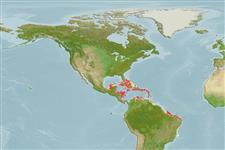分類 / Names
俗名 | 同種異名 | Catalog of Fishes(屬, 種) | ITIS | CoL | WoRMS | Cloffa
Environment: milieu / climate zone / depth range / distribution range
生態學
海洋 礁區魚類. 熱帶; 27°N -
Western Atlantic: Bahamas and Central America to northern South America.
西大西洋: 巴哈馬與中美洲到南美洲北部。
大小 / 重量 / 年齡
Maturity: Lm ? range ? - ? cm
Max length : 5.0 cm TL 雄魚/尚未辨別雌雄; (Ref. 9710)
簡短描述
檢索表 | 型態特徵 | 形態測量圖
Dark green, with 17-23 pale green bars. Brownish stripe through eye interrupted by bright red spot.
深綠色的, 藉由 17-23條灰綠色橫帶。 褐色的斑紋經過眼藉著鮮紅色斑點中斷。
Inhabits pitted limestone faces and tide pools in surf areas in clear waters. Usually found among spines of rock-boring sea urchins (Ref. 26938). A protogynous hermaphrodite (Ref. 55367). Has been reared in captivity (Ref. 35420).
在清澈的水域中的海浪區域中棲息於石灰岩凹洞面與潮池。 通常發現於岩石-鑽孔海膽的棘中。 (參考文獻 26938) 一個雌性先熟的雌雄同體.(參考文獻 55367) 曾經後面在繁殖場.(參考文獻 35420)
Life cycle and mating behavior
成熟度 | 繁殖 | 產卵場 | 卵 | 孕卵數 | 仔魚
Benthic spawner. A monandric species (Ref. 55367). Sex reversal is completed in 3-5 weeks (Ref. 34185, 31410). Length at sex change = 2.0 cm TL (Ref. 55367). Males have a unique paired, secretory, accessory gonadal structures (AGS) associated with the testis (Ref. 103904).西大西洋: 巴哈馬與中美洲到南美洲北部。
Robins, C.R. and G.C. Ray, 1986. A field guide to Atlantic coast fishes of North America. Houghton Mifflin Company, Boston, U.S.A. 354 p. (Ref. 7251)
IUCN 瀕危狀態 (Ref. 130435: Version 2024-1)
無危 (LC) ; Date assessed: 01 March 2010
人類使用
漁業: 商業性; 水族館: 商業性
工具
特別的報告
下載 XML
網路資源
Estimates based on models
Preferred temperature (Ref.
123201): 26.8 - 28.2, mean 27.6 °C (based on 493 cells).
Phylogenetic diversity index (Ref.
82804): PD
50 = 0.5000 [Uniqueness, from 0.5 = low to 2.0 = high].
Bayesian length-weight: a=0.00724 (0.00339 - 0.01546), b=3.10 (2.92 - 3.28), in cm total length, based on LWR estimates for this (Sub)family-body shape (Ref.
93245).
營養階層 (Ref.
69278): 3.2 ±0.3 se; based on size and trophs of closest relatives
回復力 (Ref.
120179): 高度, 族群倍增時間少於 15個月 (Preliminary K or Fecundity.).
Fishing Vulnerability (Ref.
59153): Low vulnerability (10 of 100).
